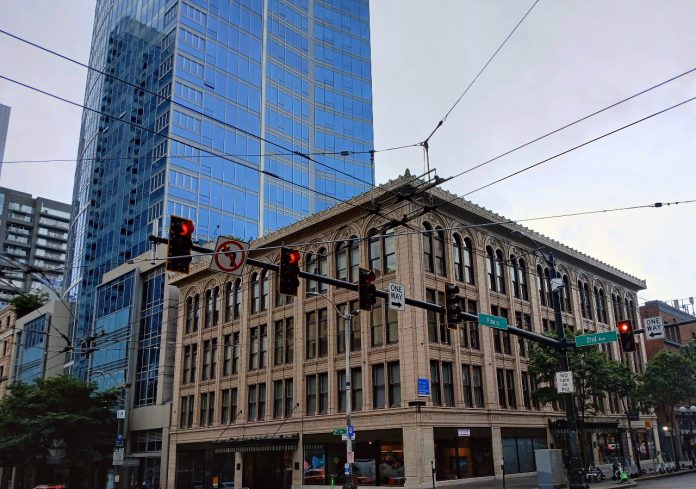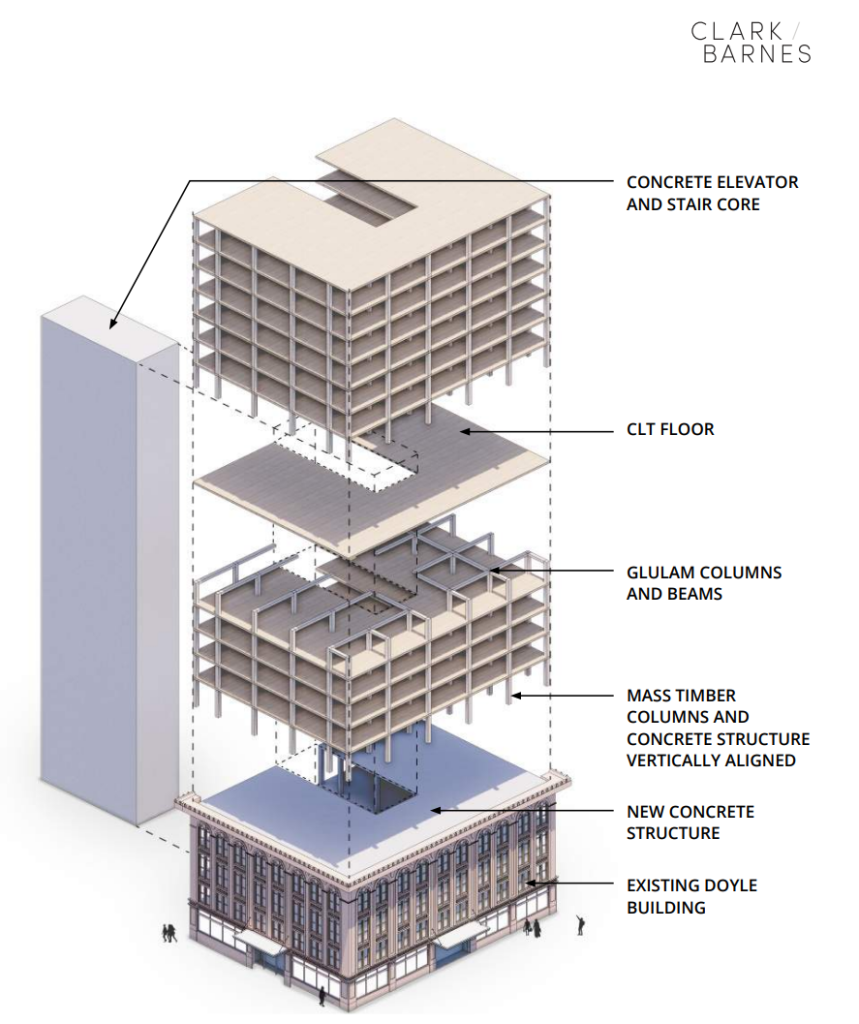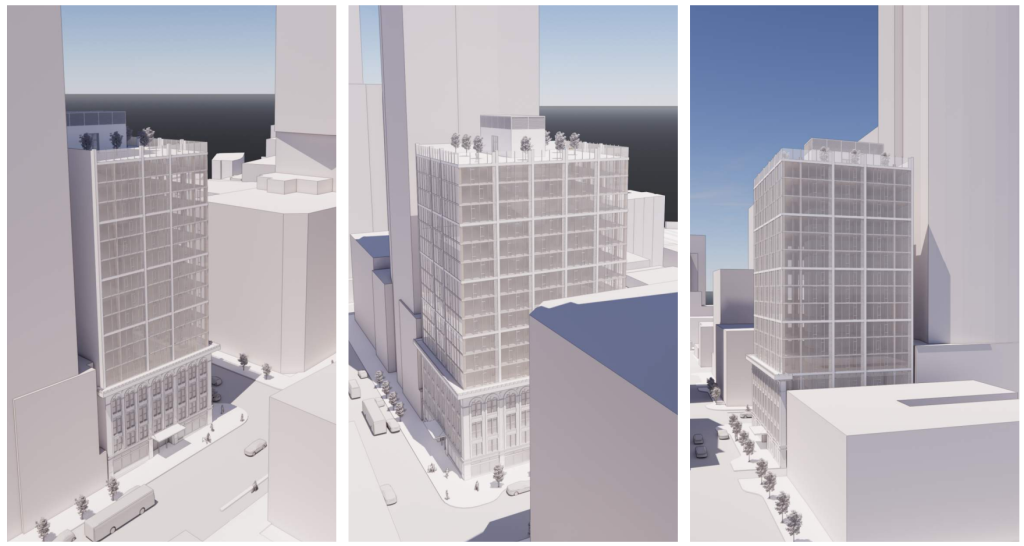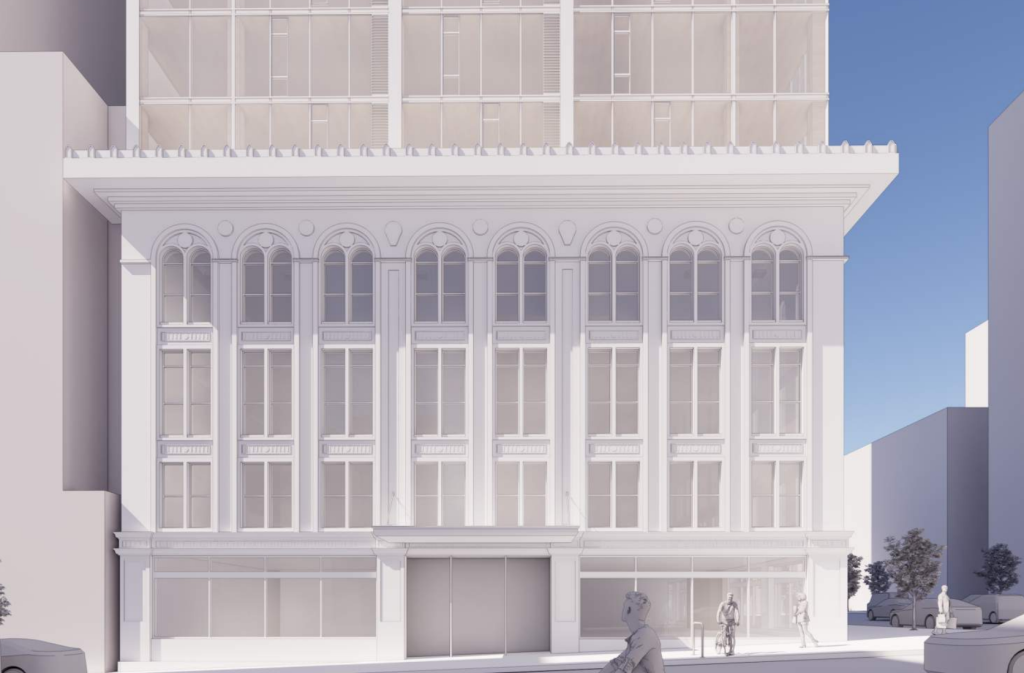
If one point of general consensus exists among Seattleites around what would help to improve the state of downtown, it’s adding more permanent residents. But a proposal to add more housing above a historic office building near Pike Place Market is bringing out significant opposition, with nearby condominium owners seeking to utilize the only point of leverage they have: the city’s landmarks board.
Clark/Barnes architects are working with the owners of the Doyle Building, a four-story landmarked building dating from 1920, and are looking to give the building a big upgrade that addresses the realities of high vacancy levels in downtown offices. Their proposal would take advantage of a suite of newly approved state and city policies approved with the express purpose of making it easier to build housing.
Architects propose retaining the facade of the existing structure and adding 12 additional floors of new construction on top. That new addition would consist of mass timber, allowing a smaller foundation and less weight on the historic building below.

If executed, the project would represent a remarkable confluence of housing reforms across multiple levels of government from recent years. Located downtown, it’s exempt from both design review requirements and review under the State Environmental Policy Act (SEPA). By converting office use to residential, it would be eligible to take advantage of new sales and use tax exemptions recently implemented at the city level, following a change in state law.
Finally, it could be one of the first projects in the state to take advantage of newly approved House Bill 1183, which prohibits cities from requiring upper-level setbacks when mass timber construction is involved, allowing the project to maximize the number of units built — though it’s notable that as smaller tower in downtown, setbacks and facade modulation wouldn’t normally be required for this project.
But the city’s landmarks preservation board still needs to sign off on major changes to the Doyle building. At an initial briefing Wednesday, board members were open to a new chapter for the building, even as they wanted to see more details on how this change would be implemented. Most of the opposition to the project came from members of the public, including a large faction of condo owners from 1521 Second Avenue, right next door.
“[T]he proposal is advanced in bad faith, lacking the transparency and good intentions expected in matters of historic preservation. It is aesthetically inconsistent with the purposes of Seattle’s preservation laws, which aim to maintain the architectural integrity and historical character of our city’s landmarks,” neighbors Timothy and Joanie Kosnoff wrote the board. “Approving this project would set a terrible precedent for other historic preservation building owners and prospective owners, potentially encouraging similar disregard for preservation standards.”

Another recurring theme in the early public comment on this project is that downtown doesn’t need more housing — at least not market-rate housing.
“Building more-of-the-same is not the answer for an economic chain reaction caused by overbuilding. This proposal is for market rate housing,” Ruth Danner, President of Savethemarketentrance.org, which was created to block a proposal to build a new hotel nearby at First Avenue and Pike Street, wrote in a letter to the board. “Seattle does not need more market rate housing. This proposal just knocks over another domino that will force another and another to fall. This proposal disregards the ability of the neighborhood to absorb its mass.”
As proposed, converting the Doyle Building to residential use would generate nearly $2 million in funding for subsidized affordable housing, via the city’s Mandatory Housing Affordability program. Apart from the benefits that come from more residences downtown — including more eyes on the street to deter crime and foot traffic — more homes downtown reduce pressures on existing housing stock in the neighborhood and the broader city.
Historic Seattle, one of the city’s most influential historic preservation advocacy organizations, opposed the proposal in a letter earlier this week that veered considerably from its core mission of preservation, citing impacts on the nearby vegetable garden.
“While they are proposing to repair, restore, or replace in-kind character-defining features on the two primary facades (east and north), they are ignoring the fact that a 12-story addition would have an adverse impact to the landmark,” Eugenia Woo, Historic Seattle’s Director of Preservation Services, wrote the board. “The addition is out-of-scale and incompatible with the landmark building. It treats the landmark building as a four-story base for the new tower, completely upending the original and historic proportions of the landmark.”
There’s plenty of precedent in Seattle for landmark structures being supplemented with new structures, including nearby in downtown with a seven-story addition to the 1913 Federal Reserve Bank building completed in 2020.
None of the interior spaces in the Doyle building are landmarked, so the big question is whether the new addition conforms with the original intent to landmark the exterior. While certainly open to the proposal, the primary concerns raised by landmarks board members related to the scale of the addition versus the original building.
“For me, what it comes down to is: it does, as some people have noted already, does seem to overwhelm the landmark,” board member Matt Inpanbutr said.
“I think that’s the primary issue, so that it doesn’t dominate the building below,” board member Katie Randall said. “I think it really comes down to: is it going to feel top-heavy in a way that it’s floating above the existing building below.”

“I’m intrigued by how this structurally interacts with the building, the historic property […] I’m still always uncomfortable with large towers really being attached to the top of historic buildings,” board chair Ian Macleod said. “I’d love to hear more about how this develops, but I think what I would like more, perhaps, is alternate proposals for this.”
Design review boards of all stripes do usually see multiple options to decide which is more palatable, but the architects presenting here were clear that the constraints that come from constructing the addition of mass timber mean that this really is the only configuration that makes financial sense for the site.
“To be perfectly frank, if we are forced to set the addition back, that will basically mean that we can’t do the project, simply because it will not be suitable for residential use and also would not be financially viable,” Scott Clark of Clark/Barnes told the board. In other words, if the landmarks board and the architects reach an impasse, there may not be a direct path forward.
The project remains in early stages, but it’s clear that the fight over the Doyle Building could shape up to be one of the most contentious fights over a housing project downtown in many years, joining the ranks of the Escala tower-spacing debate or the fight over 2616 Western Avenue.
Ryan Packer has been writing for The Urbanist since 2015, and currently reports full-time as Contributing Editor. Their beats are transportation, land use, public space, traffic safety, and obscure community meetings. Packer has also reported for other regional outlets including BikePortland, Seattle Met, and PubliCola. They live in the Capitol Hill neighborhood of Seattle.




